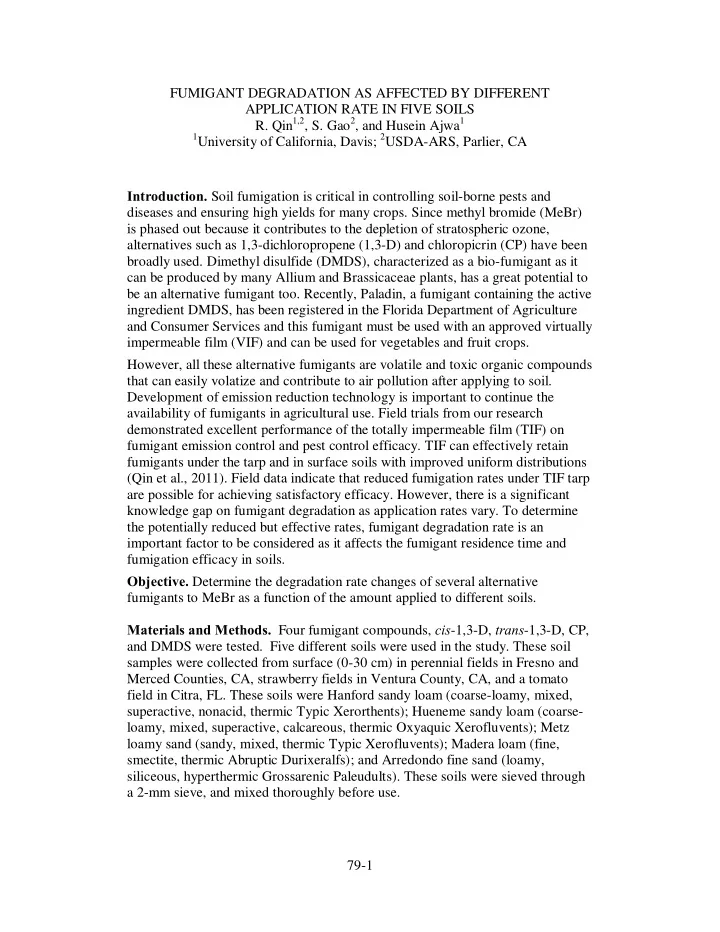

FUMIGANT DEGRADATION AS AFFECTED BY DIFFERENT APPLICATION RATE IN FIVE SOILS R. Qin 1,2 , S. Gao 2 , and Husein Ajwa 1 1 University of California, Davis; 2 USDA-ARS, Parlier, CA Introduction. Soil fumigation is critical in controlling soil-borne pests and diseases and ensuring high yields for many crops. Since methyl bromide (MeBr) is phased out because it contributes to the depletion of stratospheric ozone, alternatives such as 1,3-dichloropropene (1,3-D) and chloropicrin (CP) have been broadly used. Dimethyl disulfide (DMDS), characterized as a bio-fumigant as it can be produced by many Allium and Brassicaceae plants, has a great potential to be an alternative fumigant too. Recently, Paladin, a fumigant containing the active ingredient DMDS, has been registered in the Florida Department of Agriculture and Consumer Services and this fumigant must be used with an approved virtually impermeable film (VIF) and can be used for vegetables and fruit crops. However, all these alternative fumigants are volatile and toxic organic compounds that can easily volatize and contribute to air pollution after applying to soil. Development of emission reduction technology is important to continue the availability of fumigants in agricultural use. Field trials from our research demonstrated excellent performance of the totally impermeable film (TIF) on fumigant emission control and pest control efficacy. TIF can effectively retain fumigants under the tarp and in surface soils with improved uniform distributions (Qin et al., 2011). Field data indicate that reduced fumigation rates under TIF tarp are possible for achieving satisfactory efficacy. However, there is a significant knowledge gap on fumigant degradation as application rates vary. To determine the potentially reduced but effective rates, fumigant degradation rate is an important factor to be considered as it affects the fumigant residence time and fumigation efficacy in soils. Objective. Determine the degradation rate changes of several alternative fumigants to MeBr as a function of the amount applied to different soils. Materials and Methods. Four fumigant compounds, cis -1,3-D, trans -1,3-D, CP, and DMDS were tested. Five different soils were used in the study. These soil samples were collected from surface (0-30 cm) in perennial fields in Fresno and Merced Counties, CA, strawberry fields in Ventura County, CA, and a tomato field in Citra, FL. These soils were Hanford sandy loam (coarse-loamy, mixed, superactive, nonacid, thermic Typic Xerorthents); Hueneme sandy loam (coarse- loamy, mixed, superactive, calcareous, thermic Oxyaquic Xerofluvents); Metz loamy sand (sandy, mixed, thermic Typic Xerofluvents); Madera loam (fine, smectite, thermic Abruptic Durixeralfs); and Arredondo fine sand (loamy, siliceous, hyperthermic Grossarenic Paleudults). These soils were sieved through a 2-mm sieve, and mixed thoroughly before use. 79-1
Fumigant stock solution was prepared by dissolving each compound into ethyl acetate. Three sets of experiments were carried out. In the 1 st experiment, a mixture of cis -1,3-D, trans -1,3-D, and CP with equivalent amount for each compound was tested. For any fumigant compound, four fumigant application rates (10, 50, 100, and 200 mg kg -1 ) were applied to the soils. The 2 nd incubation experiment only included 1,3-D isomers with equivalent amount for each compound. For each 1,3-D isomer, three application rates (10, 50, and 80 mg kg -1 ) were tested. The 3 rd incubation experiment was conducted with DMDS at the rates of 20, 80, 120, and 160 mg kg -1 . For incubation, after weighing 8 g soil (dry mass) into 20 ml glass vials, 5 µ L fumigant solution was injected into the soils with a 10- µ L micro-syringe. Then the vials were immediately sealed with Teflon-faced butyl rubber septa and aluminum crimp seals and incubated at 22 ºC. The soil water content was adjusted to 10% (w/w) for the four soils from California and 5% (w/w) for the sandy soil from Florida. After incubating 1, 2, 4, 6, 8, 11, and 14 d, vials in triplicate were placed into a -80 ºC freezer until extraction of remaining fumigants. Results and Discussion. All the incubation experiments showed that fumigant degradation over time followed pseudo first-order kinetics. The degradation rate constant ( k , d -1 ), which is inversely related to the half-life of a chemical, as a function of fumigant amount applied to Madera loam soil is shown in Figure 1 as an example. The k values varied inversely with the applied fumigant rate for all fumigants and all soil types. The data indicate that as fumigant application rate increases to soil, fumigant degradation rate would decrease or half-life increase significantly. The k values decrease more significantly for CP and DMDS than 1,3-D isomers for all the soils. Similar to CP and DMDS, the steep decrease of methyl iodine (MeI) degradation with the increasing MeI amount (from 7 to 74 mg kg -1 ) was reported by Guo and Gao (2009). These findings suggest that a proper fumigant rate for ensuring good efficacy must be determined by considering the fumigant property and the soil type. An overdose of fumigant may delay tarp-cutting time or cause phytotoxicity for crops, while too low a fumigant level may not be able to achieve the fumigation efficacy target. References Cited: Qin, R., S. Gao, H. Ajwa, D. Sullivan, D., Wang, and B.D. Hanson. 2011. Field evaluation of a new plastic film (Vapor Safe TM ) to reduce fumigant emissions and improve distribution in soil. J. Environ. Qual. 40:1195 � 1203. Guo, M., and S. Gao . 2009. Degradation of methyl iodide in soil: Effects of environmental factors. J. Environ. Qual. 38:513-519. 79-2
0.8 cis-1,3-D 0.7 trans-1,3-D Degradation rate constant (d -1 ) 0.6 CP 0.5 DMDS 0.4 0.3 0.2 0.1 0 0 50 100 150 200 250 Fumigant rate (mg kg -1 ) Figure 1. The degradation rate constant (d -1 ) of 1,3-dichloropropene (1,3-D) isomers cis -1,3-D, trans -1,3-D, chloropicrin (CP), and dimethyl disulfide (DMDS) as affected by different fumigant rates in Madera loam soil. 79-3
Recommend
More recommend